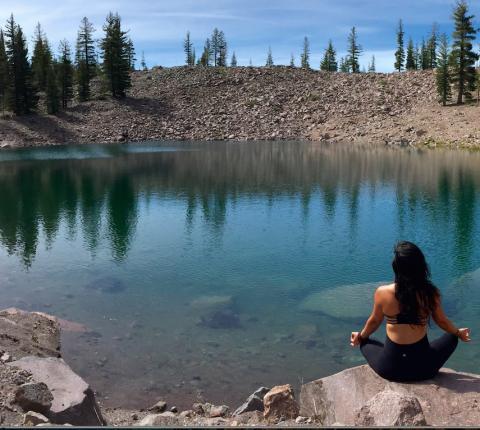
Pranayama is a powerful Yogic practice that clears physical and emotional blockages from the body, breathing peace into the mind.
“Yoga citta vritti nirodhaha.”
“The restraint of the modifications of the mind-stuff is yoga.” - Patanjali
Consider it a stepping-stone to bring clarity and quiet to all the mind’s chatter. Pranayama is generally described as breath control. In Sanskrit we can understand “prana” to mean “our life force, vital energy” and “ayama” to be the “extension and expansion” of that. In this practice, we find infinite benefits to conscious breathing, but one of the most immediate is the sense of calm that canvasses one’s entire being.
Here are 4 Pranayama techniques to calm the chaos of the mind:
1. Nadi Shodhana: Alternate Nostril Breathing
In Sanskrit “Nadi” refers to the channels that run through our body and “Shodhana” means “cleaning or purifying.” This practice is often used to cleanse the body of waste and purify the mala of the mind (extinguishing the six enemies of passion, anger, pride, delusion, jealousy and greed.)
Benefits
- Purifies body
- Clears energetic channels and releases toxins
- Balances solar masculine energies with lunar feminine energies
- Relieves anxiety and stress
- Improves concentration
- Lowers heart rate
- Calms and nervous system
How to practice:
- Find a comfortable seat, perhaps cross-legged on a blanket. Sit up tall, lengthening the spine.
- Rest left palm on knee; perhaps face up in a gesture of receptivity or any desired mudra hand gesture.
- Allow your eyes to flutter closed, turning awareness inward.
- Bring your right hand to your forehead and allow the pointer and middle finger to rest upon your Third Eye Ajna Charka – the space between your brows.
- Draw in a deep inhale through the nose and exhale through the nose.
- Close your right nostril with your thumb and inhale through the left nostril slowly
- At the end of the inhalation, close the left nostril with your ring finger and retain breath for a brief moment.
- Release thumb from right nostril and allow the breathe to slowly dissolve
- At the bottom of your exhale, pause briefly. Inhale through the right side slowly.
- At the top of the inhalation, retain the breath for a moment using thumb and ring finger.
- Release ring finger, exhaling through left nostril. Pause at the bottom of your breath.
- Repeat the cycle (Steps 6-11) for about 5-10 rounds.
Tips: The ratio of your breath should be 1:1. Try counting “om one, om two, om three, om four” on the in-breath. Retain for one “om” and then exhale “om one, om two, om three, om four.” As your practice evolves you may be able to draw deeper breaths. Note that there are several variations to perform this pranayama.
2. Sheetali Pranayama
The sheetali breath is a cooling breath. It stems from the word “Sheetal” meaning “that which is calm, passionless and soothing.” Note that about a third of the population genetically cannot perform this Pranayama, but Sheetkari will promote the same benefits.
Benefits
- Cools the body
- Reduces mental and emotional excitement
- Induces muscular relaxation
- Promotes mental tranquility
- Often used to calm oneself before sleep
- Gives control over hunger and thirst
How to practice:
- Find a comfortable seat, perhaps cross-legged on a blanket. Sit up tall, lengthening the spine.
- Rest palms on your knees; perhaps face up in a gesture of receptivity or any desired mudra hand gesture.
- Allow your eyes to flutter closed, turning awareness inward.
- Roll the tongue from the sides so it creates a tube or straw
- Inhale slowly through the tube of your tongue
- At the end of the inhalation draw your tongue inside your mouth
- Exhale through the nose
- Repeat the cycle (Steps 5-7) for 9 to 15 rounds
3. Sheetkari Pranayama: The Hissing Breath
Similar to Sheetali, this pranayama is a cooling breath that does wonders for anxiety and depression.
Benefits
- Cools the body
- Reduces mental and emotional excitement
- Induces muscular relaxation
- Promotes mental tranquility
- Promotes healthy teeth and gums
- Often used to calm oneself before sleep
- Gives control over hunger and thirst
How to practice:
- Find a comfortable seat, perhaps cross-legged on a blanket. Sit up tall, lengthening the spine.
- Rest palms on your knees; perhaps face up in a gesture of receptivity or any desired mudra hand gesture.
- Allow your eyes to flutter closed, turning awareness inward.
- Gently hold teeth together and allow teeth to be exposed
- The tongue may remain flat, or folded against the palate
- Inhale slowly through your teeth, allowing the breath to cool.
- At the end of the inhalation draw your tongue inside your mouth
- Exhale through the nose
- Repeat the cycle (steps 6-8) for 9 to 15 rounds
4. Bhramari Pranayama: The Humming Bee Breath
This breathing technique is considered one of the most effective pranayamas for preparing the mind for meditation.
Benefits
- Relieves stress
- Alleviates cerebral tension
- Helps pacify anger
- Reduces anxiety
- Settles insomnia
- Improves voice and vocal chords
- Helps with migraines
- Induces meditation by harmonizing mind and directing awareness within
- Calms the nervous system
- Assists with high blood pressure
How to perform:
- Find a comfortable seat, perhaps cross-legged on a blanket. Sit up tall, lengthening the spine.
- Allow your eyes to flutter closed, turning awareness inward.
- Relax the jaw, keeping lips closed and teeth slightly separated (this will allow the vibration to be felt more fully).
- Take your index fingers and press into the flap of your ears in order to plug both ears without physically inserting the fingers. Note that you can modify hand positioning as needed.
- Draw your awareness to the 3rd Eye Ajna Chakra, the space between the brows.
- Inhale through the nose
- Exhale slowly while humming the resonant sound of a black bee. The sound should be soft and allow for vibrations to flow to the front of the forehead.
- Repeat the cycle (steps 5-8) for 5 to 10 rounds. As practice deepens you may increase number of rounds.
Tips: In cases of extreme anxiety one can practice this for up to 30 minutes and experience great healing benefits.
These are just a few of the many Pranayama practices that heal the body and mind. Give them a try and see which ones best suit you. Understand that Pranayama practice should be built upon. While our life force prana has the ability to remove blockages from the body and heal every layer of our being, it is important to respect the evolution of your practice. (Believe it or not, too much prana can be problematic). Take these breathing exercises slowly. The ones listed above are great for beginners and advanced practitioners alike. Notice the differences in your physical and subtle body and allow the breath to guide you to peace.
For more insight on breathing, check out "The Importance of Breath: The Anatomical and Energetic Lowdown"
A great resource for Yogic practices is the book Asana Pranayama Mudra and Bandha by Swami Satyananda Saraswati. The pranayamas may be found there in greater depth.








